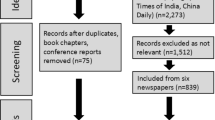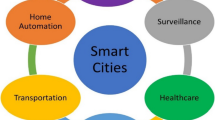Abstract
Spatial regression is applied to GPS floating car measurements to build a predictive model of road system speed as a function of link type, time period, and spatial structure. The models correct for correlated spatial errors and autocorrelation of speeds. Correlation neighborhoods are based on either Euclidean or network distance. Econometric and statistical methods are used to choose the best model form and statistical neighborhood. Models of different types have different coefficient estimates and fit quality, which might affect inferences. Speed predictions are validated against a holdout sample to illustrate the usefulness of spatial regression in road system speed monitoring.





Similar content being viewed by others
References
Anselin L (1988) Spatial econometrics: methods and models. Kluwer Academic, Dordrecht
Balmer M, Bernard M, Axhausen KW (2005) Matching geo-coded graphs. Swiss Transport Research Conference, Swiss Federal Institute of Technology, Ascona
Bernard M, Hackney J, Axhausen KW (2006) Correlation of link travel speeds. Swiss Transport Research Conference, Swiss Federal Institute of Technology, Ascona
Bhat C, Guo J (2004) A mixed spatially correlated logit model formulation and application to residential choice modeling. Transportation Res B 38:147–168
Bivand R (1998) A review of statistical techniques for location studies. CEPR Symposium on New Issues in Trade and Location (2277), Norwegian School of Economics and Business Administration, Lund, Sweden
Black WR, Thomas I (1998) Accidents on Belgium’s motorways: a network autocorrelation analysis. J Trans Geogr 6:23–31
Bolduc D, Dagenais MG, Gaudry MJI (1989) Spatially autocorrelated errors in origin-destination models: a new specification applied to aggregate mode choice. Trans Res B 23:345–359
Bolduc D, Laferrière R, Santarossa G (1992) Spatial autoregressive error components in travel flow models. Reg Sci Urban Econ 22:371–385
Bradley M, Bowman J (2006) A summary of design features of activity-based micro simulation models for U.S. MPOs. TRB Conference on Innovations in Travel Demand Modelling, Austin
Griffith DA (1996) Practical handbook of spatial statistics. CRC, Boca Raton
Guo JY, Bhat C (2007) Operationalizing the concept of neighborhood: application to residential location choice analysis. J Trans Geogr 15:31–45
Hunt JD, Kriger DS, Miller EJ (2005) Current operational urban land-use-transport modelling frameworks: a review. Trans Rev 25:329–276
Kim S-E, Niemeier D (2001) A weighted autoregressive model to improve mobile emissions estimates for locations with spatial dependence. Trans Sci 35:413–424
LeSage JP (2000) Spatial econometrics. Working Paper, University of Toledo, Toledo
LeSage JP (2005) Applied econometrics using Matlab. Working Paper, University of Toledo, Toledo
Maddala GS (2001) Introduction to econometrics, 3rd edn. Wiley, West Sussex
Marchal F, Hackney J, Axhausen KW (2006) Efficient map-matching of large GPS data sets—tests on a speed monitoring experiment in Zurich. Trans Res Rec 1935:93–100
Miller HJ (1999) Potential contributions of spatial analysis to geographic information systems for transportation (GIS-T). Geogr Anal 31:373–399
Nagel K, Esser J, Rickert M (2000) Large scale traffic simulations for transportation planning. Annual review of computational physics. World Scientific, Singapore
Nagel K, Wagner P, Woesler R (2003) Still flowing: approaches to traffic flow and traffic jam modelling. Oper Res 51:681–710
National Institute of Standards and Technology NIST (2006) e-Handbook of statistical methods. Retrieved 30 January 2006, from http://www.itl.nist.gov/div898/handbook/
Navteq Corporation (2004) High resolution digital road network of Canton Zurich. Frankfurt
Okabe A, Okunuki K, Shiode S (2006) SANET: a toolbox for spatial analysis on a network. Geogr Anal 38:59–66
Páez A, Scott D, Potoglou D, Kanaroglou P, Newbold KB (2007) Elderly mobility: demographic and spatial analysis of trip making in the Hamilton CMA, Canada. Urban Stud 55:123–146
Páez A, Scott DM (2004) Spatial statistics for urban analysis: a review of techniques with examples. Geojournal 61:53–67
Páez A, Suzuki J (2001) Transportation impacts on land use change: an assessment considering neighborhood effects. J East Asia Soc Trans Stud 4:47–59
Peeta S, Ziliaskopoulous AK (2001) Foundations of dynamic traffic assignment: the past, the present and the future. Netw Spat Econ 1:233–265
Public Works Office of the Canton Zurich, P. u. S. (2002) Der Einsatz des Kantonalen Verkehsmodells im Rahmen der Zweckmässigkeitsbeurteilungen, Synthesebericht (The evaluation of the Cantonal transportation model, Summary Report). Zurich, Baudirektion Kanton Zurich
Salvini PA, Miller EJ (2005) ILUTE: an operational prototype of a comprehensive microsimulation model of urban systems. Netw Spat Econ 5:217–234
Steenberghen T, Dufays T, Thomas I, Flahaut B (2004) Intra-urban location and clustering of road accidents using GIS: a Belgian example. Geogr Inf Sci 18:169–181
Stetzer F (1982) Specifying weights in spatial forecasting models: the results of some experiments. Environ Plan A 14:571–584
Swiss Federal Statistical Office (2001) Travel behaviour results from the 2000 Microcensus travel. Mobility in Switzerland. Swiss Federal Office for Spatial Development and Swiss Federal Statistical Office. Berne, SFSO and ARE
Tobler WR (1970) A computer model simulating urban growth in the Detroit region. Econ Geogr 46:234–240
U.S. Department of Transportation Federal Highway Administration (1997) Model validation and reasonableness checking manual. Travel Improvement Program, U.S. Department of Transportation, Federal Highway Administration
Waddell P, Ševcíková H, Socha D, Miller EJ, Nagel K (2005) Opus: an open platform for urban simulation. Computers in Urban Planning and Urban Management Conference (CUPUM), London
Wegener M (ed) (2004) Overview of land use transport models. Handbook of transport geography and spatial systems. Elsevier, Oxford
Zhao H, Bhat C (2002) The spatial analysis of activity stop generation. Trans Res B 36:557–575
Zhou B, Kockelman KM (2005) Neighborhood impacts on land use change: a multinomial logit model of spatial relationships. Paper presented at the 52nd North American Regional Science Association International (RSAI) Conference, Las Vegas, Nevada, (2005)
Acknowledgments
The authors thank Thomas Niederöst of Zurich’s planning office and Jean Wolf of GeoStats for support in gathering GPS data, and James LeSage for help in applying the Econometrics Toolbox for Matlab to this task. The remarks of anonymous reviewers greatly improved the clarity and helped place the work in its most relevant context.
Author information
Authors and Affiliations
Corresponding author
Rights and permissions
About this article
Cite this article
Hackney, J.K., Bernard, M., Bindra, S. et al. Predicting road system speeds using spatial structure variables and network characteristics. J Geograph Syst 9, 397–417 (2007). https://doi.org/10.1007/s10109-007-0050-4
Received:
Accepted:
Published:
Issue Date:
DOI: https://doi.org/10.1007/s10109-007-0050-4




